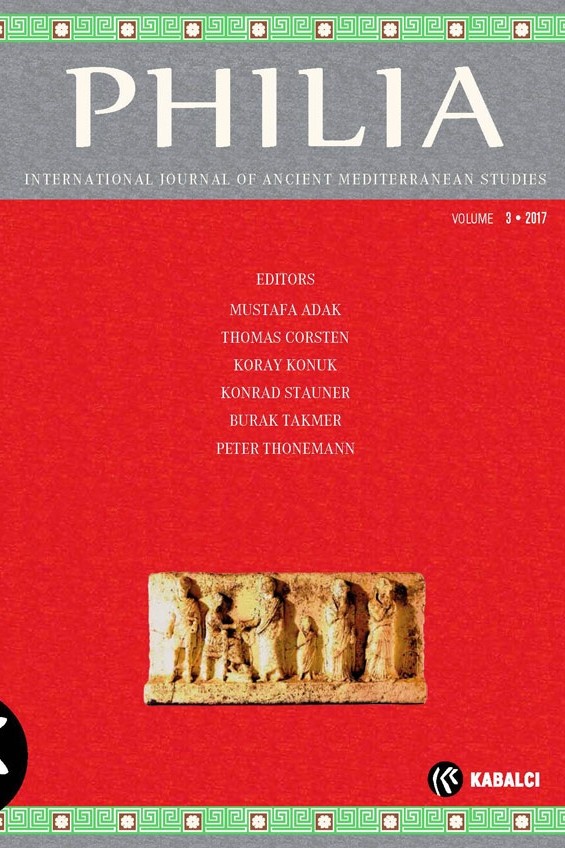Constitutio Antoniniana’nın ardından Roma Vatandaşlığı ve Yunan Onomastiği: Pamphylia ve Bithynia Yazıtlarında –ιανός Cognomen'leri
Caracalla’nın 212 yılında imparatorluk içerisinde
yaşayan köle olmayan herkese Roma vatandaşlığı bahşetmesiyle birlikte
imparatorluğun doğu eyaletlerinin ahalisi birbirlerinden oldukça farklı olan Hellen
ve Roma isimlerini değişik çözümlemelerle bir arada kullanmıştır. 212 yılı
sonrasına tarihlenen Hellen yazıtları bize çok az sayıda Küçük Asya
eyaletinde isme genellikle baba adıyla ilgili yeni soy isim eklenme yoluna
gidildiğini göstermektedir: Örneğin, Demetrios oğlu Aurelius Sosibios sonraları
ismini Aurelius Demetrianos Sosibios olarak değiştirecektir. Burada üzerinde
özellikle durmak istediğimiz konu yeni soy isimlerinin bazen babadan ziyade
yakın akraba ya da kadın adlarıyla bağlantılı oluşudur. Böylelikle doğrudan
kan bağından ziyade yakınlık belirtilmektedir. Makalede ayrıca bu karakterdeki
isimlerin Küçük Asya’da hangi bölgelerde görüldüğü üzerinde durulmaktadır.
Benzer isim yapısının çok uzun zamandır görülüp kayıt altına alındığı
Pamphylia ve bazı komşu bölgeleri bir kenara koyarsak, benzer isim yapısı
Küçük Asya’nın kuzeyinde Bithynia Bölgesi’nde çok sayıda kentte görülür. Yazar
tarafından Severuslar Hanedanı döneminde doğuya düzenlenen seferlerde Bithynia Bölgesi’nin
geçiş güzergahı üzerinde olması neticesinde, Roma’nın yeni vatandaşlarını,
önceki isim alma yöntemlerini sistematik olarak değiştirmeye teşvik etmiş
olabileceği öne sürülmektedir.
Anahtar Kelimeler:
Constitutio Antoniniana, Roma vatandaşlığı, onomastik adetler, Pamphylia, Bithynia
Citoyenneté romaine et onomastique grecque au lendemain de la constitutio Antoniniana: les cognomina en –ιανός dans les inscriptions de Pamphylie et de Bithynie
As of 212 when Caracalla extended Roman citizenship
to all free inhabitants of the empire, people in the Eastern provinces used
various ways to bring together the widely different Greek and Roman onomastic
formulae. Greek inscriptions of the post-212 period show that a few provinces
of Asia Minor chose a particular style by adding a new cognomen, usually
related to the father’s name, between the nomen Aurelius and the diacritical cognomen:
Aurelius Sosibius son of Demetrius, for instance, later changed his name to
Aurelius Demetrianus Sosibius. We first intend to stress that such new cognomina
may sometimes be related to feminine names or to some relatives other than the
father, thus indicating kinship rather than direct filiation. We then consider
which provinces across Asia Minor shared this characteristic onomastic style.
Beside Pamphylia and some neighbouring provinces where such cognomina have been
noticed long ago, several cities of Bithynia in Northern Asia Minor shows a
very similar onomastic pattern. It is suggested that the frequent imperial
expeditions crossing Bithynia during the Severan period encouraged new Roman
citizens to systematically transform their previous nomenclature.
Keywords:
Constitutio Antoniniana, Roman citizenship, onomastic habit, Pamphylia, Bithynia,
___
- Adak 2007 M. Adak, Zwei neue Archontenlisten aus Prusias ad Hypium, Chiron 37, 2007, 1–10.
- Bean – Mitford 1965 G. E. Bean – T. B. Mitford, Journeys in Rough Cilicia in 1962 and 1963, Wien 1965.
- Bean – Mitford 1970 G. E. Bean – T. B. Mitford, Journeys in Rough Cilicia 1964–1968, Wien 1970.
- Buraselis 2007 K. Buraselis, ΘΕΙΑ ΔΩΡΕΑ. Das göttlich-kaiserliche Geschenk. Studien zur Politik der Severer und zur constitutio Antoniniana, Wien 2007.
- Corsten 2010 Th. Corsten, Names in -ΙΑΝΟΣ in Asia Minor: a Preliminary Study, in: R. W. V. Catling – F. Marchand (éd.), Onomatologos. Studies in Greek Personal Names presented to Elaine Matthews, Oxford 2010, 456–463.
- Daux 1977 G. Daux, L’onomastique romaine d’expression grecque, in: H. G. Pflaum (éd.), L’onomastique latine: actes du Colloque International sur l’Onomastique Latine organisé à Paris du 13 au 15 oct. 1975, Paris 1977, 405–417.
- Destephen 2008 S. Destephen, Prosopographie chrétienne du Bas Empire 3. Prosopographie du diocèse d’Asie, 325–641, Paris 2008.
- Fernoux 2004 H.-L., Fernoux, Notables et élites des cités de Bithynie aux époques hellénistique et romaine (IIIe s. av. J.-C. - IIIe s. ap. J.-C.). Essai d'histoire sociale, Lyon 2004.
- Keil et al. 1935 J. Keil – H. Swoboda – F. Knoll, Denkmäler aus Lycaonien, Pamphylien und Isaurien, Leipzig – Wien 1953.
- Laminger-Pascher 1973 G. Laminger-Pascher, Index grammaticus zu den griechischen Inschriften Kilikiens und Isauriens, Wien 1973.
- Rizakis 2011 A. Rizakis, La diffusion des processus d’adaptation onomastique: les Aurelii dans les provinces orientales de l’Empire, in: M. Dondin-Payre (éd.), Les noms de personne dans l’Empire romain, Bordeaux 2011, 253–262.
- Stauner – Schwartz 2007 K. Stauner – H. Schwartz, Die Parapompé des Kaisers und seines Heeres im nordwestlichen Kleinasien, Gephyra 4, 2007, 1–35.
- ISSN: 2149-505X
- Başlangıç: 2015
- Yayıncı: Kabalcı Yayıncılık
Sayıdaki Diğer Makaleler
Nikaia’dan, Istampajları Köln’deki Arşivde Bulunan İki Mezar Epigramı
Sezgin Köksal Koleksiyonu’ndan Apameia Myrleia’ya (Mudanya) Ait Yeni Yazıtlar
Zotion Adı ve Ignatius’un Mektubunun Güvenilirliği
Contantinus’a ait Ticinum Madalyonu ve Üç-Tanrılı Brakteat’ların Kökeni
Karadeniz Ereğli Müzesi’nden Herakles Aleksikakos’a Sunulan Bir Adağın Düşündürdükleri
Serdica Konsili M.S. 343: Doğu ve Batı Kiliselerinin Yol Ayrımı Mı?
Phrygia’dan Dionysos İçin Yeni Bir Adak Yazıtı
Küçük Asya’da Diadokhoi Savaşları: Kardia’lı Eumenes’in Savaş Stratejisi
Antalya Müzesi’nden Yeni Adak ve Mezar Yazıtları
Portulanlar ve Portulan Haritaları Işığında Hellespontos ve Bithynia Sahilleri
